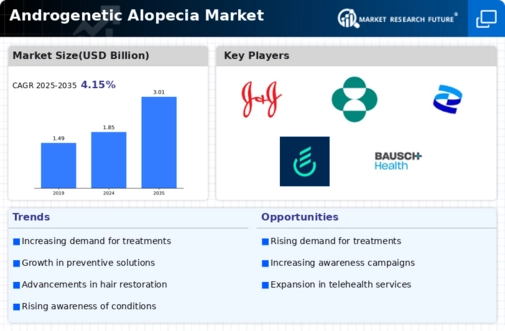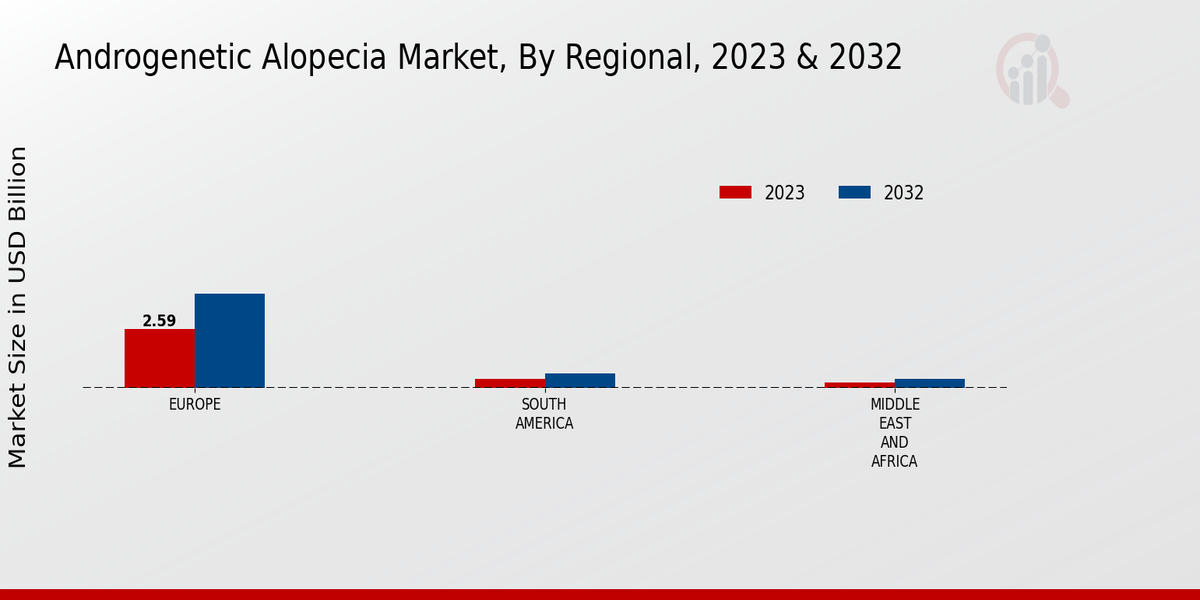Market Growth Projections
The Global Androgenetic Alopecia Market Industry is poised for robust growth, with projections indicating a market value of 1.85 USD Billion in 2024 and an anticipated increase to 3.01 USD Billion by 2035. This growth trajectory reflects a compound annual growth rate of 4.51% from 2025 to 2035. Such figures highlight the increasing demand for effective hair loss treatments and the evolving landscape of the industry. The market's expansion is likely to be driven by a combination of factors, including advancements in treatment options, rising awareness, and demographic shifts, positioning the industry for sustained growth in the coming years.
Advancements in Treatment Options
Innovations in treatment methodologies, including topical solutions, oral medications, and surgical interventions, are propelling the Global Androgenetic Alopecia Market Industry forward. Recent developments in hair restoration technologies, such as follicular unit extraction and platelet-rich plasma therapy, have shown promising results. These advancements not only enhance treatment efficacy but also improve patient satisfaction. The growing availability of minimally invasive procedures is likely to attract a broader demographic seeking solutions for hair loss. As a result, the market is expected to expand significantly, with projections indicating a growth to 3.01 USD Billion by 2035, reflecting a compound annual growth rate of 4.51% from 2025 to 2035.
Emerging Markets and Economic Growth
The expansion of the Global Androgenetic Alopecia Market Industry is also fueled by emerging markets experiencing economic growth. Countries in Asia-Pacific and Latin America are witnessing a rise in disposable incomes, leading to increased spending on personal care and health-related products. As consumers in these regions become more affluent, the demand for effective hair loss treatments is likely to surge. This trend presents significant opportunities for market players to introduce innovative products tailored to local preferences. The potential for growth in these emerging markets is substantial, as they represent a new frontier for the Global Androgenetic Alopecia Market Industry.
Aging Population and Lifestyle Factors
The demographic shift towards an aging population, coupled with lifestyle factors such as stress and poor nutrition, is influencing the Global Androgenetic Alopecia Market Industry. As individuals age, the likelihood of experiencing hair loss increases, particularly in men. Furthermore, modern lifestyles characterized by high stress levels and inadequate dietary habits are contributing to the prevalence of androgenetic alopecia. This demographic trend is expected to drive demand for hair loss treatments, as older adults seek solutions to maintain their appearance and self-esteem. The market's response to these demographic changes is crucial for addressing the needs of this growing consumer base.
Increasing Prevalence of Androgenetic Alopecia
The rising incidence of androgenetic alopecia globally serves as a primary driver for the Global Androgenetic Alopecia Market Industry. It is estimated that approximately 50 million men and 30 million women in the United States alone experience some degree of hair loss. This trend is not limited to the U.S., as similar patterns are observed across various regions, indicating a widespread concern. The increasing awareness and acceptance of hair loss treatments contribute to market growth, with the market projected to reach 1.85 USD Billion in 2024. Such figures underscore the urgency for effective solutions in the Global Androgenetic Alopecia Market Industry.
Rising Awareness and Acceptance of Hair Loss Treatments
The increasing awareness and societal acceptance of hair loss treatments are driving the Global Androgenetic Alopecia Market Industry. Educational campaigns and the proliferation of information through digital platforms have empowered consumers to seek solutions for hair loss. This shift in perception has led to a growing demand for various treatment options, including over-the-counter products and professional services. Moreover, the rise of social media influencers advocating for hair restoration has further normalized the conversation around hair loss. Consequently, this heightened awareness is likely to contribute to the market's growth trajectory, as more individuals actively pursue effective treatments.
















